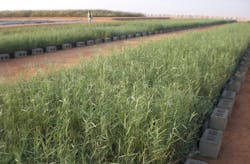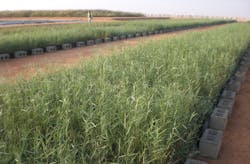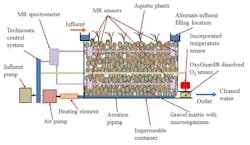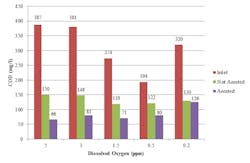Reed Bed Installations
Understanding Challenging Clogging
Constructed wetlands have gained popularity to treat industrial and municipal wastewater. Although these can be operated for 10 years without human intervention, eventually they can become clogged. A €1.1 EU funded two-year project set out to address how autonomous reed bed installations (ARBI) can help lead to a reduction in clogging rate.
By Theodore Hughes-Riley
Autonomous
Constructed wetlands have received increasing levels of interest in recent years as a clean, cost-effective and environmentally friendly form of treatment for both domestic and industrial wastewater. A normal constructed wetland, sometimes known as a reed bed, is typically comprised of a gravel bed through which wastewater flows facilitating its treatment.
The interstitial spaces between the gravel particles form a network of connected channels through which the effluent flows. Over time, microorganisms start to grow on the surface of gravel stones forming microbial biofilms. These are responsible for removing pollutants from the wastewater as it passes over them, with chemical processes and physical filtration also playing a role in eliminating contaminants.
Many such wetlands will often also include aquatic plants such as the common reed (Phragmites Australis) or yellow flag Iris (Iris Pseudacorus). These assist the process through insulation, nutrient recycling, solids knockdown and stimulation of a broader microbial diversity within the bed.
Human intervention
A common feature added to commercial wetlands is aeration which increases the oxygen-transfer within the beds, and therefore treatment performance as the prime mechanism of action is aerobic microbial degradation.
Furthermore, the heating of wetlands can prevent certain microorganisms becoming dormant in the winter months, further improving the beds operability in all seasons.
Wetlands have been seen to operate without human intervention for around 10 years before the microbial biofilms and particulates significantly occlude the interstitial spaces in the aggregate and severely retard water flow. Eventually these voids become so occluded, or clogged, that the bed will experience bypass or surface flow, leading ultimately to untreated water reaching the water course.
As a result, maintenance of beds in this state must be carried out, which is both time consuming and costly. One method currently used to reduce the effects of clogging is step-feeding. As biofilm growth is most pronounced at the location where the bed is fed with influent, to prevent prohibitive clogging in this part of the bed the feeding location is moved. This will to some extent also happen naturally as the clogged areas see bypass flow to neighbouring areas of the bed.
Clogging levels are typically determined using tracer dyes, where a dye will be put into the bed in one location and then monitored further down in the fluid stream. However, this is a time consuming process and can take a number of days to carry out.
Recent advances have allowed for the clog state to be determined in real time using a magnetic resonance sensor. Magnetic resonance is best known in everyday life for medical Magnetic Resonance Imaging (MRI). Unlike such systems however, the probes used for such measurements are very small and inexpensive, becoming economical to be buried in the gravel bed permanently.
Reducing the clogging rate
The autonomous reed bed installation (ARBI) project is an EU FP7 initiative to develop an optimised water treatment system with a focus on the reduction of clogging rate. The aim is to allow the beds to operate without human intervention for longer than would normally be possible. The consortium comprises five companies and two universities from four different European nations.
The autonomous reed bed installation project began in September 2013, with €1.1 million of funding to run the two year research and development project. Now nearing the projects end, the prototype ARBI modules are now well into the testing phase, where the water treatment capabilities of the autonomously controlled bed are being compared to the those of a conventional bed with no aeration, heating, or step feeding, and that of a bed with constant forced aeration.
These tests are being carried out on both municipal and industrial wastewater. Each ARBI module is a completely self-contained unit with an advanced network of embedded sensors to control a variety of factors. An aeration system has been included to ensure that the optimal dissolved oxygen concentration for microorganism health is achieved. This is controlled by a dissolved oxygen sensor, so that the aeration is only activated when necessary, saving power. An autonomously controlled heating element is used to maintain a temperature above a threshold allowing for a consistent level of water treatment all year round in any temperate climate.
Finally, MR sensors are used to signal a change in the feeding location on the bed depending on the distribution of clogging and inform the end user once the bed has become critically clogged.
Bubble size
The fact that the prototype testing stage has been reached shows that one of the major project aims, to fully develop a modular constructed wetland system, has been achieved.
A lot of the efforts of the project have gone into developing the ideal design for these modules and as a consequence the optimal operational parameters had to be investigated. One area that was a focus of research activities, was determining the preferential parameters for the aeration system, this included details such as the correct bubble size for uniform distribution across the bed and critically the level of the dissolved oxygen within the bed that would yield the best contaminant removal. While additional improvements are seen at higher levels of aeration, these are not sufficiently beneficial to warrant the additional power required. Another key goal of the project was to contribute to addressing the gap between research and innovation on eco-technologies applied to wastewater treatment.
Additionally, a core area of the research was to investigate the capabilities of magnetic resonance to detect the clogging level within the constructed wetlands. This was as well subsequently developing a field deployable probe intended for long term embedding into wetlands.
While various types of MR probe were investigated in this project, the final MR probe was prepared using permanent Neodymium magnets in a fully waterproofed housing, suitable for long-term embedding into gravel beds. The clogging probes collect information about the sample using MR relaxation measurements which tell us about the environment of water molecules and therefore tell us about the extent of clogging.
Understanding the clogging process
Of the two main relaxation parameters, T1 has been shown to be sensitive to clog state and its potential for determining the relative proportions of free water, biofilms and other suspended solids in the sample was investigated in this project.
In particular, a bulk measurement that does not separate out the different components can give a good indication of how clogged the wetland is and would prove adequate for controlling the step feeding system.
As shown in the diagram of the ARBI module, the probes are deployed at different locations and depths within the bed to provide the control system with as complete a picture of the locations of clogging as possible. Not only will this allow the ARBI system to make informed decisions about the step feeding location but the development of this clog state sensing technology may lead to a better understanding of the clogging process within wetlands.
Ultimately, ARBI provides a number of advantages over conventional wetlands. When a regular bed clogs, the site must go offline while the beds are replaced and refurbished. ARBI's modular nature means that the unit can be collected and replaced more rapidly than the alternatives. This also allows for a quick and simple initial installation as the beds will be stored seeded and ready to function from the point of connection.
The use of aeration and heating allow for a superior treatment efficiency, which means that the ARBI modules can be smaller than a non-aerated bed. Finally the inclusion of the clog sensors and autonomous step-feeding will mean that ARBI will have a longer operational lifetime between refurbishments, compensating for the limited operational lifetimes of conventional wetland installations.
Theodore Hughes-Riley is a research fellow at Nottingham Trent University. Contributing authors include: Patrick Hawes, Enrica Uggetti, Lauren Mowberry, Christophe L. Trabi, Dario Ortega Anderez, Elizabeth R. Dye, Fraser Hill-Casey, J. Beau W. Webber, Jaume Puigagut, Joan García, Michael I. Newton, Robert H. Morris. For further information on the ARBI modules and for the latest updates, please see the project website at http://arbi-eu.com
More Water & WasteWater International Archives Issue Articles



